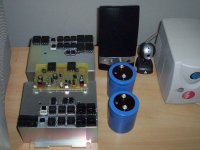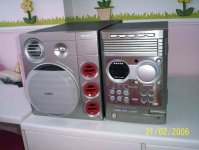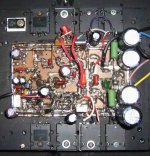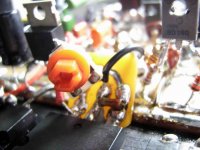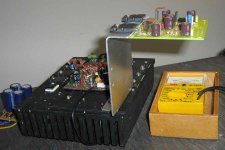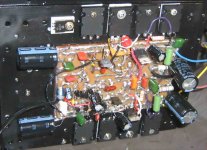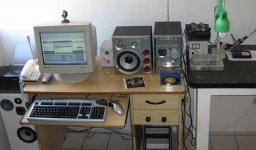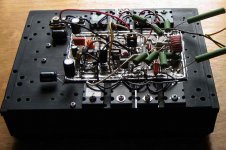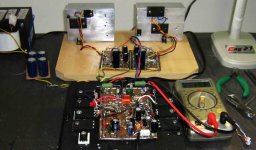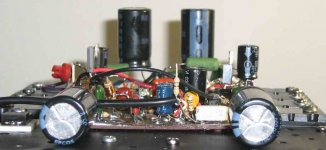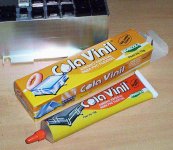There is a nice heatsink calculator on the ESP website which will allow you to calculate the rateing of your heatsink too, as well as an article discussing heatink calculations.
Our friend Hugh Dean did a back of the head calculation and suggested a heatsink in the region of 0.3C/W with which it would still run "pretty bloody hot" to quote his exact words.
So for useing this in high power mode you will need a significant heatsink...
As stated Sonrads in australia carries suitable ones and I would not think twice befoer selecting an even bigger one than the suggested unit. their prices are dirt cheap. Two of those sinks would be less than AUD60.
When I get a chance I will look at some US catalogs and check what we can find for Europe.
Our friend Hugh Dean did a back of the head calculation and suggested a heatsink in the region of 0.3C/W with which it would still run "pretty bloody hot" to quote his exact words.
So for useing this in high power mode you will need a significant heatsink...
As stated Sonrads in australia carries suitable ones and I would not think twice befoer selecting an even bigger one than the suggested unit. their prices are dirt cheap. Two of those sinks would be less than AUD60.
When I get a chance I will look at some US catalogs and check what we can find for Europe.
I could not see Rodd or Conrad into this thread to help us
hehehe... at least i am here trying to help, despite you prefer others dear nephew.
This method is to be used, as a help, when you have not that ratio you show (C/W)... when people has not that data.... when they have saved some heatsinks from junk, or dismounted some amplifiers and have heatsinks.
So.... they can read what i have post, Conrad and Elliot will not gave them the heatsink numbers(C/W).
regards,
Carlos
hehehe... at least i am here trying to help, despite you prefer others dear nephew.
This method is to be used, as a help, when you have not that ratio you show (C/W)... when people has not that data.... when they have saved some heatsinks from junk, or dismounted some amplifiers and have heatsinks.
So.... they can read what i have post, Conrad and Elliot will not gave them the heatsink numbers(C/W).
regards,
Carlos
The science guys avoid this thread but they will be quick to jump in and explain further that there is more to just the dimentions of a fin, therr is the spaceing between adjacent fins, the colour of the fins, thinkness of fins, speed of air movement etc...
If someone has the best instructional information available that I found usefull, I am surely ot going to keep it under a bucket.
When it comes to heatsink calculation I have learned my first expensive lesson buying too big sinks after following the wrong advice... that is all... not to agree or dissagree with anyone, just putting out a diffirent (more conventional way) of doing the calculations for the people who follows that type of information more easily.
If someone has the best instructional information available that I found usefull, I am surely ot going to keep it under a bucket.
When it comes to heatsink calculation I have learned my first expensive lesson buying too big sinks after following the wrong advice... that is all... not to agree or dissagree with anyone, just putting out a diffirent (more conventional way) of doing the calculations for the people who follows that type of information more easily.
Precision I and Precision II will be tested here
You do not see the supply, only some auxiliary electrolitic condensers.
Also the board you see is not a Precision board, the one is there only to show you the position will be glued into the heatsinks.
Heatsinks, those 2 X 130 watts of audio power, continuous power heatsinks (to work cool while 130 watts of audio, each rail audio power, is beeing transfered to the speaker) will provide the cooling, auxiliary fan may help to keep this position you see into the prototype.
The transistors you see are for Precision 1 and others to Precision 2... VAS transistors will not go to heatsink into the prototype.
Those heatsinks will be attached into a piece of plywood.... and because of that i can even not to use insulators in some transistors....i have just to keep heatsinks insulated one refered to the other.
This is not to be pretty, it is to be huge.... to hold more than 250 watts over 4 ohms..and to accept some testing over 1.6 ohms too.
Prototype board, a new one, because i have already made and test all that stuff into the month of September 2007, will be submited to huge tests this time.
Board will be those copper side soldered parts and soon it will be heating my room..... those heatsinks can hold more than 400 watts of music power (the music average power)...and 260 continuous, sinusoidal, undistorted.
Transistors had the metal back side sanded with grain 500 over a piece of flat glass and they are glued into the heatsink...glue is special that contracts... this way hold the transistor in place.
My watt values into heatsinks are not dissipation watts the way you know, it is based into my own experience, were 100 square inches of aluminium, exposed to the air (one side only calculation) will face a 10 watts amplifier, undistorted continuous sinusoidal signal... to operate less than 10 degrées celsius above environment temperature.
regards,
Carlos
You do not see the supply, only some auxiliary electrolitic condensers.
Also the board you see is not a Precision board, the one is there only to show you the position will be glued into the heatsinks.
Heatsinks, those 2 X 130 watts of audio power, continuous power heatsinks (to work cool while 130 watts of audio, each rail audio power, is beeing transfered to the speaker) will provide the cooling, auxiliary fan may help to keep this position you see into the prototype.
The transistors you see are for Precision 1 and others to Precision 2... VAS transistors will not go to heatsink into the prototype.
Those heatsinks will be attached into a piece of plywood.... and because of that i can even not to use insulators in some transistors....i have just to keep heatsinks insulated one refered to the other.
This is not to be pretty, it is to be huge.... to hold more than 250 watts over 4 ohms..and to accept some testing over 1.6 ohms too.
Prototype board, a new one, because i have already made and test all that stuff into the month of September 2007, will be submited to huge tests this time.
Board will be those copper side soldered parts and soon it will be heating my room..... those heatsinks can hold more than 400 watts of music power (the music average power)...and 260 continuous, sinusoidal, undistorted.
Transistors had the metal back side sanded with grain 500 over a piece of flat glass and they are glued into the heatsink...glue is special that contracts... this way hold the transistor in place.
My watt values into heatsinks are not dissipation watts the way you know, it is based into my own experience, were 100 square inches of aluminium, exposed to the air (one side only calculation) will face a 10 watts amplifier, undistorted continuous sinusoidal signal... to operate less than 10 degrées celsius above environment temperature.
regards,
Carlos
Attachments
The adhesive i use is made of sinthetic rubber
Transparent material, very hard and super flexible that constitutes a very strong material when dried.
It smells alike the old "Revell" glue, that one used to build some Revell kits, airplanes, boats and automobiles.... that one able to melt some kind of plastic.
Also used to fix rubber boats, PVC boats, plastic boats, and to fix tires...it is not the contact cement..you do not need to put both sides....it is a liquid that evaporates the solvent and reduces the weigth to 3 percent...the solvent goes to the air, transformed into gases.
Once glued into the place it is very hard to remove.
regards,
Carlos
Transparent material, very hard and super flexible that constitutes a very strong material when dried.
It smells alike the old "Revell" glue, that one used to build some Revell kits, airplanes, boats and automobiles.... that one able to melt some kind of plastic.
Also used to fix rubber boats, PVC boats, plastic boats, and to fix tires...it is not the contact cement..you do not need to put both sides....it is a liquid that evaporates the solvent and reduces the weigth to 3 percent...the solvent goes to the air, transformed into gases.
Once glued into the place it is very hard to remove.
regards,
Carlos
Re: The way to evaluate heatsinks
I think that's brilliant, for a rule of thumb.
..Todd
destroyer X said:
I have a trick, something developed along many years building, a simple
way to discover if a heatsink will fit or not..... because there are moments you do not have specifications and you have to evaluate using your experience.
I think that's brilliant, for a rule of thumb.
..Todd
Hi guys,
Thanks for the info on payment Nico. There are no worries with trusting your site with my CC details!!! I just didn't see where payment was mentioned on the site without going through the checkout process.
As for those Conrad heatsinks, I think these are the exact ones I mentioned which were also sold by the Australian retailer 'Altronics' - who do have a website, by the way. Below is a link to the heatsinks...
http://www.altronics.com.au/index.asp?area=prod&grp=19
Cheers
Stuey
Thanks for the info on payment Nico. There are no worries with trusting your site with my CC details!!! I just didn't see where payment was mentioned on the site without going through the checkout process.
As for those Conrad heatsinks, I think these are the exact ones I mentioned which were also sold by the Australian retailer 'Altronics' - who do have a website, by the way. Below is a link to the heatsinks...
http://www.altronics.com.au/index.asp?area=prod&grp=19
Cheers
Stuey
Well TAJ, i am so ashamed about this heatsink..using glue in the place of screws
is excelent, attach the transistors in a wonderfull way and it is resistant till 90 degrées celsius..but distance between them are wrong, convection position to heatsink is wrong too...the use of wires are wrong too..so...it is a colection of errors.
At least i have sanded the transistor back to have them flat to transfer heat (this was rigth!)...but thank you very much.
The trick developed along years building because i had strange heatsinks without specifications result an overkill into the dimensions, as they are dimensioned to hard work, to continuous power, not for music power, and because of that, they run cool when working, in special when the "formula user" leave into an environment is not so hot alike mine (now more confortable, raining daily and temperature is 25 degrées célsius).
regards,
Carlos
.......................................................................................................
Eva
My main audio equipment is a small system from Phillips, it is a class D working 45 plus and 45 minus.... delivery of power is more than a hundred watts rms and works cool...heatsink is for 5 watts amplifier and it has a fan removing heat from inside the enclosure... clever holes made into the board creates a flux of air that keep them around 40 degrées celsius.
I like the audio, it is very nice, incredible that into specifications distorts a lot, but you feel them nice...so.... we are not too much sensitive to distortions...friends and family likes the sound and i use the pré amplifier output (headphone output) as my pré amplifier, as my audio source, because it is the only analogic circuit i have inside that case.
I do not like to touch the output wires...i feel the electricity there... switching into 500 kilohertz filtered power, but something remains there and it is very annoying.
regards,
Carlos
.......................................................................................................
My dear Aussie friend
Those heatsinks are great, and not an accident that Hugh Dean use them....hehehehe..you know how i like his work, he is my teacher, the master of audio in my point of view.
I was thinking about the subject...i have evaluated (my way) the heatsink possibilities and found it to 120 watts continuous..this means can hold 240 musical watts (peak, not average, not continuous, small time power..inside the audio envelope)... also having the enclosure made using aluminium, all this together will result into a perfect heatsink to amplifier that can go more than 200 watts each channel... and temperature will go above 55 degrées celsius because of the transformers and because no holes enougth were made under and over the enclosure.
regards,
Carlos
is excelent, attach the transistors in a wonderfull way and it is resistant till 90 degrées celsius..but distance between them are wrong, convection position to heatsink is wrong too...the use of wires are wrong too..so...it is a colection of errors.
At least i have sanded the transistor back to have them flat to transfer heat (this was rigth!)...but thank you very much.
The trick developed along years building because i had strange heatsinks without specifications result an overkill into the dimensions, as they are dimensioned to hard work, to continuous power, not for music power, and because of that, they run cool when working, in special when the "formula user" leave into an environment is not so hot alike mine (now more confortable, raining daily and temperature is 25 degrées célsius).
regards,
Carlos
.......................................................................................................
Eva
My main audio equipment is a small system from Phillips, it is a class D working 45 plus and 45 minus.... delivery of power is more than a hundred watts rms and works cool...heatsink is for 5 watts amplifier and it has a fan removing heat from inside the enclosure... clever holes made into the board creates a flux of air that keep them around 40 degrées celsius.
I like the audio, it is very nice, incredible that into specifications distorts a lot, but you feel them nice...so.... we are not too much sensitive to distortions...friends and family likes the sound and i use the pré amplifier output (headphone output) as my pré amplifier, as my audio source, because it is the only analogic circuit i have inside that case.
I do not like to touch the output wires...i feel the electricity there... switching into 500 kilohertz filtered power, but something remains there and it is very annoying.
regards,
Carlos
.......................................................................................................
My dear Aussie friend
Those heatsinks are great, and not an accident that Hugh Dean use them....hehehehe..you know how i like his work, he is my teacher, the master of audio in my point of view.
I was thinking about the subject...i have evaluated (my way) the heatsink possibilities and found it to 120 watts continuous..this means can hold 240 musical watts (peak, not average, not continuous, small time power..inside the audio envelope)... also having the enclosure made using aluminium, all this together will result into a perfect heatsink to amplifier that can go more than 200 watts each channel... and temperature will go above 55 degrées celsius because of the transformers and because no holes enougth were made under and over the enclosure.
regards,
Carlos
Attachments
This is to refresh our minds, as things happened during August, September, October
and November..... i said no good because some problems i had related copyrigth...then, fixed those problems i had, was released into December 2007.
Offered, for free, to future group buy, into the Christmas.
Was not something that appear into our garden alike a parachutter that fell down from the skies... and suddenly appear in front of you
Had sweat on it...many models were listened, were tested, compared and evaluated.
regards,
Carlos
and November..... i said no good because some problems i had related copyrigth...then, fixed those problems i had, was released into December 2007.
Offered, for free, to future group buy, into the Christmas.
Was not something that appear into our garden alike a parachutter that fell down from the skies... and suddenly appear in front of you
Had sweat on it...many models were listened, were tested, compared and evaluated.
regards,
Carlos
Attachments
Different voltages were tested, single and dual voltage supplies
Stabilized supplies, adjustable voltage supply, rail filtering, rail electronic regulators, floating ground, NFB, capacitors adjusted one by one, subcircuits tested, bootstrapp compared to CCS, sinks and mirrors...all stuff was checked and tested and listened and evaluated and compared.
regards,
Carlos
Stabilized supplies, adjustable voltage supply, rail filtering, rail electronic regulators, floating ground, NFB, capacitors adjusted one by one, subcircuits tested, bootstrapp compared to CCS, sinks and mirrors...all stuff was checked and tested and listened and evaluated and compared.
regards,
Carlos
Attachments
Parts damaged, fingers burned...had work on it, i hope you enjoy
This will be my return...your enjoyment.
Give to me, and to yourself the chance...never offered so cheap this kind of quality..into group buy, organized by a so kind man alike Nico.
regards,
Carlos
This will be my return...your enjoyment.
Give to me, and to yourself the chance...never offered so cheap this kind of quality..into group buy, organized by a so kind man alike Nico.
regards,
Carlos
Attachments
The knowledge applied to this amplifier had not arrived from Mars
It came from long run of research...many amplifiers built, it came from our forum knowledge offered for free...it came while i was reading (disgusting things) hard discussions we could testimony into the forum, when people have talked too much and teached me a lot of things during their duel.
Came from Hugh Dean, from Michael Bittner, from Graham Maynard, from Doctor Self, from John Lindsey Hood, from Rodd Elliot, from Nelson Pass, from Magazines, from Books and in special, resulted of LOVE, passion into audio electronics.
regards,
Carlos
It came from long run of research...many amplifiers built, it came from our forum knowledge offered for free...it came while i was reading (disgusting things) hard discussions we could testimony into the forum, when people have talked too much and teached me a lot of things during their duel.
Came from Hugh Dean, from Michael Bittner, from Graham Maynard, from Doctor Self, from John Lindsey Hood, from Rodd Elliot, from Nelson Pass, from Magazines, from Books and in special, resulted of LOVE, passion into audio electronics.
regards,
Carlos
Attachments
Is those amplifiers new discoveries?
Of course they are not.
I am the result of my society, the human development, the circuits published, the books i have read, the teachers i have.
I do not think it is easy to be original, to create really new ideas...i am copying Doctor Self ideas, Giaime had used, Hugh Dean have used into old equipments he made...the input is this way.
Vas i have obtained informations from others, had gênius work made by "the Majesty" Hugh Dean.... and could not use..because exclusive design..but i have found other one good too.
The output is from Doctor Self and other "thousand" of designers...normal circuits...not stripped yellow CCS, or unobtanium dopped Mirrors, not magic stellar radiation into the bootstrapp..... things already known..... a Frankstein of sub circuits that worked fine together....just that!
regards,
Carlos
Of course they are not.
I am the result of my society, the human development, the circuits published, the books i have read, the teachers i have.
I do not think it is easy to be original, to create really new ideas...i am copying Doctor Self ideas, Giaime had used, Hugh Dean have used into old equipments he made...the input is this way.
Vas i have obtained informations from others, had gênius work made by "the Majesty" Hugh Dean.... and could not use..because exclusive design..but i have found other one good too.
The output is from Doctor Self and other "thousand" of designers...normal circuits...not stripped yellow CCS, or unobtanium dopped Mirrors, not magic stellar radiation into the bootstrapp..... things already known..... a Frankstein of sub circuits that worked fine together....just that!
regards,
Carlos
Attachments
The stupid, the very huge bass i have into the Precision II is because of
Electrocompaniet style of CCS applied into the drivers.
Just that!...of course, current was tuned, and circuit was developed by myself, but watching the Electrocompaniet schematic...they are the gênius!..not me!
I have the value to work hard, to test hard, to search hard and to offer for free...but not more than that.
A never switching hiper class A drivers to the output..something Doctor Roender had the idea too, he made another way forcing big current into the drivers...all rigth too..fine too..even more cheap and more clever.
My respects to Doctor Roender.... Mihai
regards,
Carlos
Electrocompaniet style of CCS applied into the drivers.
Just that!...of course, current was tuned, and circuit was developed by myself, but watching the Electrocompaniet schematic...they are the gênius!..not me!
I have the value to work hard, to test hard, to search hard and to offer for free...but not more than that.
A never switching hiper class A drivers to the output..something Doctor Roender had the idea too, he made another way forcing big current into the drivers...all rigth too..fine too..even more cheap and more clever.
My respects to Doctor Roender.... Mihai
regards,
Carlos
Attachments
Not cheap!... cost a lot...many transistors..big condensers into the supply
huge transformers...not cheap!
But grandfather said to me:
- "Son.... easy things has no value into this life...we have to make effort to have things to give them value....hard to find, expensive things, sacrifices, all those things united result in pleasant victories"
The parts will force you to put your hands inside your pocket and the mouse trap you have inside your pocket may have your finger tip...but the result will be good and you will not regret.
Perceive the schematic is tested and for free...perceive that Precision 1 is offered into group buy.... see that there's no profit...Nico is so honest that have lost money last group buy, into the HRII, and the guy is so obsessive into behave in a decent way that i have no doubts he will loose money once again..because this happens..there is always something we forget..and this cost money.
Really boys..for free?... even 10 centimeters of injection into the Vains!
regards,
Carlos
huge transformers...not cheap!
But grandfather said to me:
- "Son.... easy things has no value into this life...we have to make effort to have things to give them value....hard to find, expensive things, sacrifices, all those things united result in pleasant victories"
The parts will force you to put your hands inside your pocket and the mouse trap you have inside your pocket may have your finger tip...but the result will be good and you will not regret.
Perceive the schematic is tested and for free...perceive that Precision 1 is offered into group buy.... see that there's no profit...Nico is so honest that have lost money last group buy, into the HRII, and the guy is so obsessive into behave in a decent way that i have no doubts he will loose money once again..because this happens..there is always something we forget..and this cost money.
Really boys..for free?... even 10 centimeters of injection into the Vains!
regards,
Carlos
Attachments
Of course i feel good!.... a lot of folks already ordered the Precision 1
Off course i feel great inside myself.... i have done something pleople want to have...great!
I am human...i am not a machine..of course i feel some pride!
Attention:
Precision 1 has not tricks, no money included into the board price.... I said Nico to include, because the losts of money he had...i think Nico did not this way..he is very honest, a very decent man...it is a non profit boards he will order into South Africa..near his home...he will work for free to cooperate...our gratitude must go to Nico, hard work on his shoulders!
regards,
Carlos
Off course i feel great inside myself.... i have done something pleople want to have...great!
I am human...i am not a machine..of course i feel some pride!
Attention:
Precision 1 has not tricks, no money included into the board price.... I said Nico to include, because the losts of money he had...i think Nico did not this way..he is very honest, a very decent man...it is a non profit boards he will order into South Africa..near his home...he will work for free to cooperate...our gratitude must go to Nico, hard work on his shoulders!
regards,
Carlos
Attachments
- Status
- This old topic is closed. If you want to reopen this topic, contact a moderator using the "Report Post" button.
- Home
- Amplifiers
- Solid State
- Dx Precision, finally released... now debugged and better than HRII
